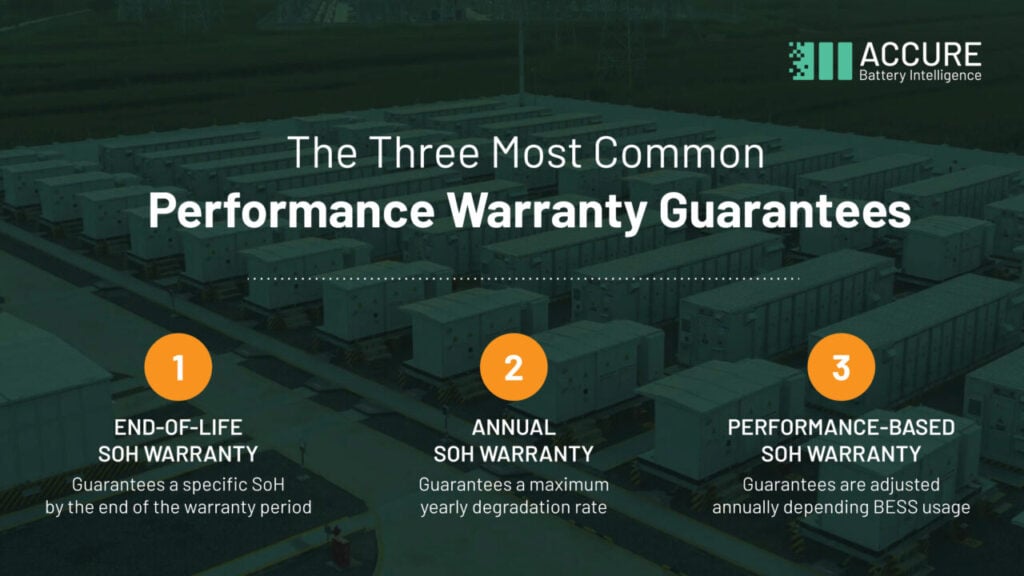
Valentin Lorscheid and Dr. Kai-Philipp Kairies of ACCURE Battery Intelligence propose ways in which BESS warranties can be reformed as the industry matures.
Inflexible and complex, the warranty model for energy storage systems has failed to keep pace with rapid market growth, the authors argue.
Enjoy 12 months of exclusive analysis
- Regular insight and analysis of the industry’s biggest developments
- In-depth interviews with the industry’s leading figures
- Annual digital subscription to the PV Tech Power journal
- Discounts on Solar Media’s portfolio of events, in-person and virtual
This is an extract of a feature article that originally appeared in Vol.41 of PV Tech Power, Solar Media’s quarterly journal covering the solar and storage industries. Every edition includes ‘Storage & Smart Power’, a dedicated section contributed by the Energy-Storage.news team, and full access to upcoming issues as well as the nine-year back catalogue are included as part of a subscription to Energy-Storage.news Premium.
As the energy storage industry scales to terawatt-hours of deployments, new approaches to warranties are essential. Recent comments from several ACCURE customers reflect a common perspective: “Battery warranties are too rigid, limiting the flexibility needed to maximise asset utility.” “I care about energy, not cycles.”
As challenging as warranties are for battery energy storage system (BESS) owners and operators, it is possible for there to be more clarity. Look no further than how the automotive industry handles electric vehicle warranties. They are simple and flexible, typically covering time (usually eight years) and mileage (usually 100,000 miles).
In contrast, BESS warranties have extensive restrictions and fine print, sometimes requiring advanced calculations to track compliance. They also tend to limit how asset owners can monetise their assets, even when operating within the technology’s physical limits.
For instance, most warranty conditions cap daily charge-discharge cycles to one or two, even though significant portions of annual revenue are generated during just a few high-demand days in some markets.
As the industry shifts from contracted revenues to higher shares of merchant operation, such limitations become increasingly costly. This raises two important questions: how can BESS warranties be updated to give suppliers clear design targets while also allowing asset owners the flexibility they need? And how can these warranties be monitored and enforced on a large scale?
The importance of BESS warranties
Warranties are vital to asset management, providing energy storage owners with assurances on performance and lifespan while giving suppliers a framework to design and differentiate their components. BESS warranties are generally divided into two categories – commercial and performance – each serving a distinct purpose.
Commercial warranty: A commercial warranty is a short-term guarantee that covers defects, part replacements, and component failures at the beginning of life (BoL). It applies to hardware components within the BESS – such as battery cells, battery management systems, safety components, inverters and other essential equipment – and usually covers only a few months.
Its primary purpose is to make sure that asset owners receive a defect-free, functioning asset at installation. These warranties are relatively straightforward. One major challenge is that defects at BoL are not always apparent and often remain unidentified during commissioning as tight project timelines push for COD. When issues surface months later, the commercial warranty may have expired, leaving the owner covering the replacement costs.
Performance warranty: A performance warranty is a guarantee that the storage system will maintain specific performance standards over a longer period—often between 15-20 years. This typically includes power output, energy availability and throughput, with degradation limits defined by key performance indicators such as state of health (SoH) and round-trip efficiency.
A well-structured performance warranty simplifies financial and operational planning, making it easier to secure investors, establish long-term service agreements and support contract negotiations with grid operators. As you can see, there are challenges inherent with both types of warranties. However, performance warranties have an added layer of complexity.
Performance warranties come in three main types, each with its own approach to degradation and usage limits:
1. End-of-Life SoH Warranty: Promises a specific SoH (typically 70–80%) by the end of the warranty period if the battery is used within the – often narrow – operating conditions laid out in the warranty contract. Exceeding these conditions, even due to issues such as sensor errors or control system malfunctions, can void the warranty.
2. Annual SoH warranty: Promises a maximum yearly degradation rate rather than just an end goal. This annual cap makes it easier to plan and track performance over time, though it still requires strict adherence to narrow operating conditions to keep the warranty valid.
3. Penalty-based warranty: Offering a more flexible approach, this type allows for adjustments in the yearly SoH guarantee depending on how the BESS is used. If the system operates under sub-optimal conditions, the guaranteed SoH may be reduced by a predefined formula.
To track the warranty status of diverse battery assets with varying penalty formulas, owners and operators increasingly switch from quarterly spreadsheet exercises to predictive monitoring platforms.

Five steps to improve today’s warranty model
Creating a more effective warranty model that addresses both supplier and end-user needs will help build a more sustainable and productive energy storage market. Here are five recommendations based on experience of supporting over 5GWh of batteries.
1. Keep it simple: Warranty conditions should be straightforward, transparent, and free from nested requirements that make it challenging for end-users to interpret and claim warranty cases. Reasonable margins for minor violations bridge the gap between contractual clarity and real-world demands, allowing operators to fully utilise the asset during peak periods without voiding the warranty.
2. Reflect practical usage patterns: Given that BESS warranties often span 15 years or more, flexibility is essential. Owners and operators require warranties that support evolving usage profiles, especially as energy markets grow more complex. By aligning warranty conditions with operational realities, a mutually beneficial relationship can develop over the asset’s lifespan.
3. Make better use of data: Predictive data analytics can unlock more flexible terms, adjusting the warranty based on actual operating conditions and real-life degradation. This approach allows warranties to adapt in response to actual BESS usage, providing owners and operators with a more responsive experience. Third-party data monitoring offers an objective view of the system, streamlines the claims process and reduces reliance on subjective assessments from the supplier.
4. Incentivise predictive maintenance: Encouraging asset owners to implement predictive maintenance strategies not only reduces the risk of system failures but could also “earn back” or even extend warranty coverage. This incentive structure promotes proactive asset management, enhancing battery longevity and overall system reliability.
5. Standardise warranty frameworks: Industry-standardised warranty terms could simplify warranty management and reduce conflicts between suppliers and end-users. By aligning on basic warranty metrics and operational limits, manufacturers, integrators and end-users could avoid the complexity that arises when different parties impose conflicting conditions.
Conclusion
The evolution of BESS warranties toward transparency, collaboration, adaptability and standardisation can pave the way for a more efficient and scalable energy storage ecosystem. A well-designed warranty framework benefits suppliers and end-users alike by ensuring long-term asset reliability while supporting flexible, revenue-optimised usage patterns.
As the industry matures, thoughtful advancements in warranty structures and predictive compliance monitoring will reduce soft costs, unlock better returns on investment and promote broader participation in energy storage markets. It’s time for BESS warranties to become less rigid.
This is an extract of a feature article that originally appeared in Vol.41 of PV Tech Power, Solar Media’s quarterly journal covering the solar and storage industries. Every edition includes ‘Storage & Smart Power’, a dedicated section contributed by the Energy-Storage.news team, and full access to upcoming issues as well as the nine-year back catalogue are included as part of a subscription to Energy-Storage.news Premium.
About the Authors
Valentin Lorscheid is a product owner at ACCURE Battery Intelligence, where he fine-tunes the analytics platform to meet the demands of an ever-evolving battery landscape. He holds an M.S. in automotive engineering and a B.S. in mechanical engineering from RWTH Aachen University.
Dr. Kai-Philipp Kairies is co-founder and CEO of ACCURE Battery Intelligence, a leading provider of solutions to manage battery safety, performance and health for electric vehicles, energy storage and other industries. He holds a Ph.D. in electrical engineering and information technology from RWTH Aachen University.

